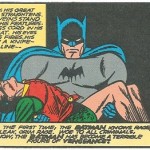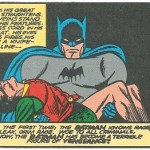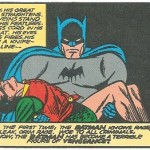What is it about Robin that makes so many Batman movies fail? Did anyone see Batman and Robin? For lack of a better description, let’s just say that movie sucked. Robin seems to doom Batman on the screen, at least when it comes to box-office revenue, yet in every Batman comic I’ve seen, Robin plays an important role–and does so without ruining the story or the Dark Knight’s mysterious, tough, dark aura. The fact that DKR features a Robin–and a girl Robin, no less –got me to thinking about Robin’s role in the Batman story because regardless of whether you like the caped crusader’s tights-clad companions or not, they’re a part of the story.
In DKR–and other post-DKR Batman stories (I’m not so sure about the ones that come before as I’m not nearly as versed), I think Robin helps remind us of the moral ambiguity that permeates the Batman universe. As we see in the newscasts, Batman is accused of using a child to shield himself from bullets. This helps thrust him further towards the criminal vigilante side of things. Who is this monster who would do such a thing to a child? It also helps shed light on the media, as we the readers know they don’t know the full story about how this Robin joined Batman in his fight. Robin helps make the Dark Knight imperfect: after all, he’s willing to put a teenager in harm’s way, and why? Does he really need the help? Or is he lonely and desperate for companionship? This imperfection–or should I say ambiguity–is a key in Batman stories. Right and wrong, good and evil, are generally presented more as questions than answers, and Batman’s use of Robin helps muddle the lines between absolute truths.
Batman appears to know the risks that accompany Robin–as he hasn’t spoken to Dick in seven years (12), implying a falling out of sorts. He also mentions James, while thinking about his promise not to let” him free” (him=batman, robin?), as he stares at the illuminated Robin costume in an otherwise dark, abandoned bat cave (19). Yet despite his promise, or the dangers that come with being a Robin, it won’t take much convincing to convince him to pick up a new sidekick in DKR.
I also think Robin plays an important role on revealing Batman’s own mortality.
Batman may appear to live forever in comics, but he’s definitely human. In DKR we see him get banged up, revealing his old age and vulnerability. Despite these bruises and scrapes, it’s usually Robin who reminds us of the real odds. Robins get kidnapped. Robins get seriously hurt. Robins die. These things happen to Robin even as Batman manages to avoid them.
But when Robin–a Batman-in-training of sorts–gets hurt, we remember that Batman is also mortal. Being the namesake of a very sucessful comic (the 400th Batman comic was released the same year as DKR) franchise, Batman can’t die. This is where Robin comes in. The Dynamic Duo frequently face off against armed thugs and supervillains using nothing but agility, cunning and a belt full of gadgets. They usually come out on top, but sometimes the bullets find a mark and the seemingly immortal duo takes a hard hit–or should I say Robin takes the hit. Batman may be immortal for his namesake, but the “Batman lites” that accompany him on his crusades get harmed, and in so doing, do they remind us that the same fate could await the man in the cape? Or do the serve as a warning against all the would-be Batmans of the world? A warning that may read: Batman may be lucky when it comes to avoiding serious harm, but before you put on your mask and cape and hit the streets of NE DC, you should think about Robin.
I know this is only the tip of the role-of-Robin iceburg. What are some of your thoughts? In writing this I also can’t help but wonder: despite Batman’s written mortality, can he ever really die? Is being a successful comic character enough to guarantee the type of invulnerability usually tied to Superman? Or is it simply the threat of death (as seen in his injuries and Robin’s death) that help make Batman relatable as a person who can die, but probably never will?



What if they DID kill off Batman and Robin took his place? Would that be (for the lack of a better word) “believable?”
Incidentally, this is why I love stories like Treme/Firefly/etc which aren’t afraid to kill off main characters. Granted, those have ensemble casts…
Er, they did that. It was called Batman R.I.P., and the current Nightwing/former Robin Dick Grayson became Batman. Of course, it’s temporary (stupid comic book death), but I thought the idea was reasonably well handled while it lasted.
good call. I’ll have to find that…
What if they DID kill off Batman and Robin took his place? Would that be (for the lack of a better word) “believable?”
Incidentally, this is why I love stories like Treme/Firefly/etc which aren’t afraid to kill off main characters. Granted, those have ensemble casts…
Can you blame a Dark Knight for putting such a foul-mouthed Robin in harm’s way?
Hmm, my embed code didn’t work.
http://www.youtube.com/watch?v=nltVuSH-lQM
Can you blame a Dark Knight for putting such a foul-mouthed Robin in harm’s way?
Hmm, my embed code didn’t work.
http://www.youtube.com/watch?v=nltVuSH-lQM
Josh,
I can’t imagine if they killed Batman and anyone took his place–that’s why they need Batman. In thinking about the role of Robin further today, I’ve also realized that few other superheroes have had such a steady sidekick. Sure, Superman has had superboy, but that’s not really a tradition. Other superheroes form leagues, but mainly as the individual superhero units coming together for some kind of greater [spin-off] good. So I guess something to think about would be not just Robin’s role, but the rare role of a sidekick. What’s that all about?
I think a Robin or sidekick character is meant to bring the target audience, typically adolescent boys, more fully into the story. As Boichel writes in his essay, “Kane, Finger, and Kane’s newly hired young assistant, Jerry Robinson, designed the Robin character to enable younger readers to identify more closely with the Caped Crusader’s adventures” (“Batman: Commodity as Myth” 8). In that way, Robin seems to have been created not to enhance or complicate our perception of Batman’s dark nature, but to help sell comics — “[Robin] was an immediate success and so widely imitated that the junior sidekick emerged as one of the most important terms in the superhero lexicon” (8).
Cynicism aside, I think Robin is meant to be a ‘Batman in training,’ “a youthful duplicate of Batman” (7), an apprentice who could take over if the master was killed. Would Robin be accepted as a new Batman or a replacement of Batman in the event of his death? I’m not sure, but probably not. But in some ways this is beside the point — there would be someone, accepted or not, that would carry on Batman’s fight if Batman were ever to fall, and this seems important to Bruce Wayne. As we can see throughout “The Dark Knight Returns,” Bruce Wayne is training Robin to fight crime according to, for lack of a better term, The Batman Code. At the text’s close, Bruce Wayne is training an army to carry on in a way he cannot because of his age. I imagine Wayne sees his new Robin leading this army and continuing Batman’s “holy war,” perhaps even taking on her own apprentice when she is older — yet another link in the chain that Batman started.
In the interview with Miller that we read, he also stressed the importance of heroes. Perhaps Robin is meant to demonstrate to us that while we can’t all be Batmen or Batwomen, we could perhaps do something, as Robin does, to contribute to Batman’s heroic cause, to channel our rage and/or trauma towards doing good as opposed to succumbing to our darkness as Harvey Dent does or mindlessly following a leader (really, any leader) as the Mutants do.
Outside of “The Dark Knight Returns,” I think you are right about Robin — he/she is meant to underscore the dangers Batman puts himself and his allies in, with these Robins often bearing the weight of the consequences of Batman’s actions. While Batman cannot die — or if he does, it can’t be a permanent death — because someone has to attract readers, Robin (or other sidekicks/characters) can die. Cynically, the death of a Robin may even help boost sales, and he or she can be replaced later on with a new incarnation, a new apprentice, a new presence to assist the Dark Knight and perhaps — if they live long enough — carry on the fight when Batman no longer can.
I definitely agree when you say that Robin’s role as a “Batman in training” is important to Batman himself. This is evident in Batman giving up the fight upon Jason’s death. If there is no one to carry on his legacy of justice, then what good is he really doing? Rather, what lasting change is he really enacting if the only good he is doing is for a single generation? Thus, bringing in a Robin who is a teenager, who can fight the fight for decades (provided she keep doing this as long as Bruce Wayne has) after Batman’s eventual death or retirement. Batman is a single symbol of justice like Superman, but a hero with a sidekick, training an army, to carry on changing the world for the better. In some ways Batman represents inspiring/training the world to change itself for the better, while Superman is there to simply protect the world from itself (or I guess the US from the rest of the world).
Since so much of DKR is about heroism and autonomy, it’s quite fascinating to study the role of the sidekick (i.e. the follower). Of course, Carrie/Robin almost always disobeys Batman’s direct orders—and usually saves his hide by doing so. So it would seem that Miller imagines that even the sidekick must operate with autonomy.
But ultimately—and I hope we can do this in class—I’d like to put Miller’s elevation of autonomy to the test and see how well it holds up under serious scrutiny.
Josh,
I can’t imagine if they killed Batman and anyone took his place–that’s why they need Batman. In thinking about the role of Robin further today, I’ve also realized that few other superheroes have had such a steady sidekick. Sure, Superman has had superboy, but that’s not really a tradition. Other superheroes form leagues, but mainly as the individual superhero units coming together for some kind of greater [spin-off] good. So I guess something to think about would be not just Robin’s role, but the rare role of a sidekick. What’s that all about?
I think a Robin or sidekick character is meant to bring the target audience, typically adolescent boys, more fully into the story. As Boichel writes in his essay, “Kane, Finger, and Kane’s newly hired young assistant, Jerry Robinson, designed the Robin character to enable younger readers to identify more closely with the Caped Crusader’s adventures” (“Batman: Commodity as Myth” 8). In that way, Robin seems to have been created not to enhance or complicate our perception of Batman’s dark nature, but to help sell comics — “[Robin] was an immediate success and so widely imitated that the junior sidekick emerged as one of the most important terms in the superhero lexicon” (8).
Cynicism aside, I think Robin is meant to be a ‘Batman in training,’ “a youthful duplicate of Batman” (7), an apprentice who could take over if the master was killed. Would Robin be accepted as a new Batman or a replacement of Batman in the event of his death? I’m not sure, but probably not. But in some ways this is beside the point — there would be someone, accepted or not, that would carry on Batman’s fight if Batman were ever to fall, and this seems important to Bruce Wayne. As we can see throughout “The Dark Knight Returns,” Bruce Wayne is training Robin to fight crime according to, for lack of a better term, The Batman Code. At the text’s close, Bruce Wayne is training an army to carry on in a way he cannot because of his age. I imagine Wayne sees his new Robin leading this army and continuing Batman’s “holy war,” perhaps even taking on her own apprentice when she is older — yet another link in the chain that Batman started.
In the interview with Miller that we read, he also stressed the importance of heroes. Perhaps Robin is meant to demonstrate to us that while we can’t all be Batmen or Batwomen, we could perhaps do something, as Robin does, to contribute to Batman’s heroic cause, to channel our rage and/or trauma towards doing good as opposed to succumbing to our darkness as Harvey Dent does or mindlessly following a leader (really, any leader) as the Mutants do.
Outside of “The Dark Knight Returns,” I think you are right about Robin — he/she is meant to underscore the dangers Batman puts himself and his allies in, with these Robins often bearing the weight of the consequences of Batman’s actions. While Batman cannot die — or if he does, it can’t be a permanent death — because someone has to attract readers, Robin (or other sidekicks/characters) can die. Cynically, the death of a Robin may even help boost sales, and he or she can be replaced later on with a new incarnation, a new apprentice, a new presence to assist the Dark Knight and perhaps — if they live long enough — carry on the fight when Batman no longer can.
I’d like to chime in on the general thoughts on the issue of Robin, but not necessarily just as the “sidekick.” Robin opened up the character of Batman to the issues of maturity, as the first Robin rebels and becomes his own vigilante, struggling to throw off and yet gain approval from the father figure of Batman. Furthermore, Batman draws vigilantes to himself, as seen here in DKR with the former Mutants who become ultraviolent vigilantes themselves, but a bit more nuanced in characters such as Oracle (the former Batgirl), the Birds of Prey, the various Robin/Batman substitutes (Azreal, Catwoman, Spoiler, Batgirl, etc). I think the reason most films fail to grasp the potential of the Batman/Robin/other vigilantes is that they cannot see Batman as functioning in a family, no matter how dysfunctional. Too bad, since Nolan’s The Dark Knight toyed with the idea of copycats, only to brutally dismiss it.
I just read the “Commodity as Myth” piece and I now have a better understanding of some of the comments. Just to clarify my post a bit, I’m most concerned with the recent, thematic and storytelling roles Robin plays in this and other recent works (including films); mostly texts since DKR. I enjoyed learning about the character’s history in “Commodity,” but I think the position of Robin in Batman comics goes far beyond Dick Tracy and a way to reach a younger audience. It serves important storytelling roles that help reveal Batman’s character and legend.